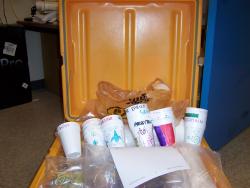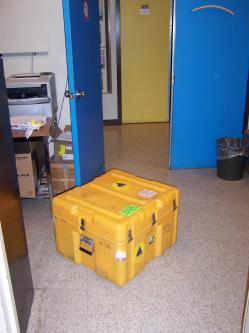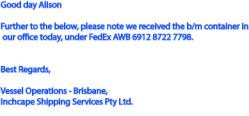Please note: You are viewing
the unstyled version of this website. Either your browser does not support CSS
(cascading style sheets) or it has been disabled. Skip
navigation.
To learn about pressure and density the EII class at the Bridgeview Montessori School is sending Styrofoam cups to the bottom of the ocean. Definitions: Density: the mass of an object compared to its volume Pressure: the amount force applied to an area Units: Most Americans think in English units (1bs, tons, ft, inches, miles etc.), but in oceanography, as in most science disciplines and much of the rest of the world, we work in metric units (kg, tonnes, m, cm, km etc.). Within this text, where it makes sense, we will make some attempt to include both.
Background: We have as much as 76 miles of atmosphere above us, so although air is extremely light compared to most things, the whole atmosphere weighs a lot: some 5.5 quadrillion (5,500,000,000,000 = 55 hundred billion) tons or 5 quadrillion tonnes (metric tons). The weight of the atmosphere exerts a pressure on all of us which is roughly equal to: 1 atm = 14.7 psi = 100,000 pa = 1000 mbar = 10 dbar. That is, if one could separate out a square column of the atmosphere that was 1 inch long by 1 inch wide, it would weigh 14.7 lbs (about the same as three 5 lb bags of sugar). We are so used to the pressure of the atmosphere that most of the time we don’t even notice it. Can you think of a time when you do? Water is denser than air. Compare the weight of an ‘empty’ gallon milk jug which is actually full of air to one which is full of water. The great density of water means that one only has to go down about 10 meters (30 ft) in the ocean feel another 14.7 psi (10 dbar) of pressure. Because every meter (3 ft) of water exerts about 1 dbar of pressure, oceanographers often use dbars and meters interchangeably. Styrofoam cups are light. They are about the same size as coffee mugs, but they weigh less. This is because Styrofoam is less dense than ceramic. That is, there is more space between the molecules of a Styrofoam cup than there is between the molecules of a ceramic cup. If we remove some of the space between the Styrofoam molecules, although their weight won’t change, they won’t take up as much room and the Styrofoam will be denser. Hypothesis: What do you think will happen to the Styrofoam cups when they are sent to the bottom of the ocean? What we need to perform the experiment:
The steps to the experiment:
Last updated: February 2, 2010 | |||||||||||||
Copyright ©2007 Woods Hole Oceanographic Institution, All Rights Reserved, Privacy Policy. | |||||||||||||



